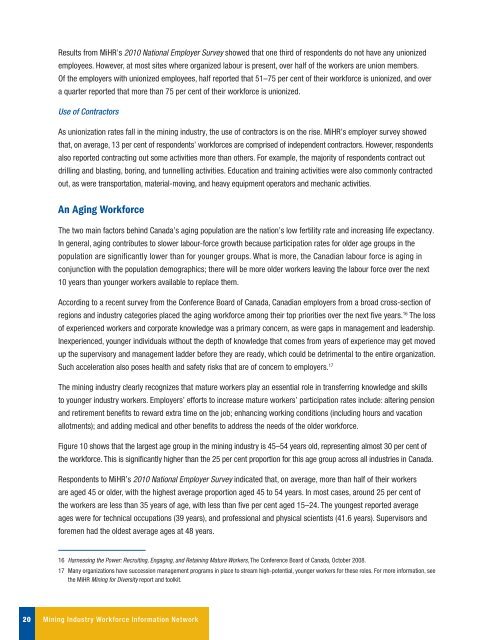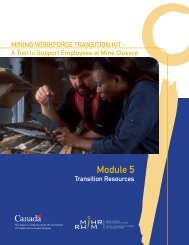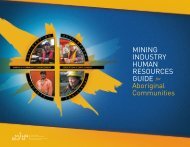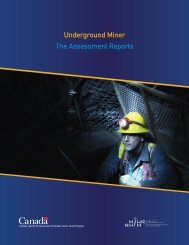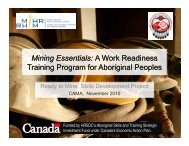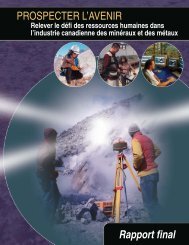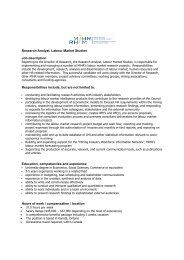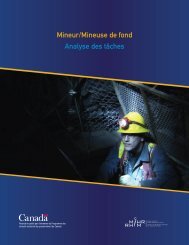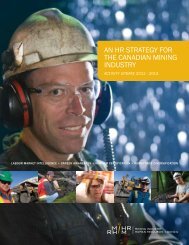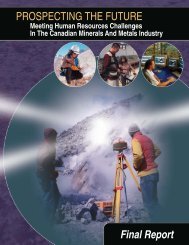Canadian Mining Industry Employment and Hiring Forecasts - MiHR
Canadian Mining Industry Employment and Hiring Forecasts - MiHR
Canadian Mining Industry Employment and Hiring Forecasts - MiHR
Create successful ePaper yourself
Turn your PDF publications into a flip-book with our unique Google optimized e-Paper software.
Results from <strong>MiHR</strong>’s 2010 National Employer Survey showed that one third of respondents do not have any unionized<br />
employees. However, at most sites where organized labour is present, over half of the workers are union members.<br />
Of the employers with unionized employees, half reported that 51–75 per cent of their workforce is unionized, <strong>and</strong> over<br />
a quarter reported that more than 75 per cent of their workforce is unionized.<br />
Use of Contractors<br />
As unionization rates fall in the mining industry, the use of contractors is on the rise. <strong>MiHR</strong>’s employer survey showed<br />
that, on average, 13 per cent of respondents’ workforces are comprised of independent contractors. However, respondents<br />
also reported contracting out some activities more than others. For example, the majority of respondents contract out<br />
drilling <strong>and</strong> blasting, boring, <strong>and</strong> tunnelling activities. Education <strong>and</strong> training activities were also commonly contracted<br />
out, as were transportation, material-moving, <strong>and</strong> heavy equipment operators <strong>and</strong> mechanic activities.<br />
An Aging Workforce<br />
The two main factors behind Canada’s aging population are the nation’s low fertility rate <strong>and</strong> increasing life expectancy.<br />
In general, aging contributes to slower labour-force growth because participation rates for older age groups in the<br />
population are significantly lower than for younger groups. What is more, the <strong>Canadian</strong> labour force is aging in<br />
conjunction with the population demographics; there will be more older workers leaving the labour force over the next<br />
10 years than younger workers available to replace them.<br />
According to a recent survey from the Conference Board of Canada, <strong>Canadian</strong> employers from a broad cross-section of<br />
regions <strong>and</strong> industry categories placed the aging workforce among their top priorities over the next five years. 16 The loss<br />
of experienced workers <strong>and</strong> corporate knowledge was a primary concern, as were gaps in management <strong>and</strong> leadership.<br />
Inexperienced, younger individuals without the depth of knowledge that comes from years of experience may get moved<br />
up the supervisory <strong>and</strong> management ladder before they are ready, which could be detrimental to the entire organization.<br />
Such acceleration also poses health <strong>and</strong> safety risks that are of concern to employers. 17<br />
The mining industry clearly recognizes that mature workers play an essential role in transferring knowledge <strong>and</strong> skills<br />
to younger industry workers. Employers’ efforts to increase mature workers’ participation rates include: altering pension<br />
<strong>and</strong> retirement benefits to reward extra time on the job; enhancing working conditions (including hours <strong>and</strong> vacation<br />
allotments); <strong>and</strong> adding medical <strong>and</strong> other benefits to address the needs of the older workforce.<br />
Figure 10 shows that the largest age group in the mining industry is 45–54 years old, representing almost 30 per cent of<br />
the workforce. This is significantly higher than the 25 per cent proportion for this age group across all industries in Canada.<br />
Respondents to <strong>MiHR</strong>’s 2010 National Employer Survey indicated that, on average, more than half of their workers<br />
are aged 45 or older, with the highest average proportion aged 45 to 54 years. In most cases, around 25 per cent of<br />
the workers are less than 35 years of age, with less than five per cent aged 15–24. The youngest reported average<br />
ages were for technical occupations (39 years), <strong>and</strong> professional <strong>and</strong> physical scientists (41.6 years). Supervisors <strong>and</strong><br />
foremen had the oldest average ages at 48 years.<br />
16 Harnessing the Power: Recruiting, Engaging, <strong>and</strong> Retaining Mature Workers, The Conference Board of Canada, October 2008.<br />
17 Many organizations have succession management programs in place to stream high-potential, younger workers for these roles. For more information, see<br />
the <strong>MiHR</strong> <strong>Mining</strong> for Diversity report <strong>and</strong> toolkit.<br />
20 <strong>Mining</strong> <strong>Industry</strong> Workforce Information Network


